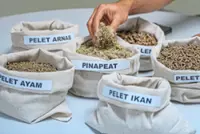Indonesian labourer Sahar working at a pineapple plantation in Kampung Parit Ghani near Simpang Renggam in Johor. — Photos: THOMAS YONG/The Star
THE growing demand globally for Malaysian pineapples spells good news for more than 3,300 farmers nationwide.
Malaysian Pineapple Industry Board (MPIB) chairman Sheikh Umar Bagharib Ali said local pineapples had high export potential.
Already a subscriber? Log in
Save 30% OFF The Star Digital Access
Cancel anytime. Ad-free. Unlimited access with perks.





